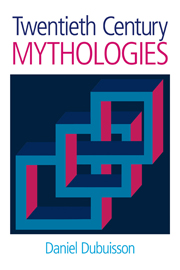Book contents
- Frontmatter
- Epigraph
- Contents
- Foreword by Professor Robert A. Segal
- Preface
- Abbreviations
- Introduction: History and comparative epistemology
- Part I Georges Dumézil, or Society
- 1 The Indo-European background
- 2 The first comparative mythologies
- 3 Durkheim, Mauss, Bourdieu, and Dumézil
- 4 The 1950s: a reorientation
- 5 Comparative and structural evidence
- 6 The new comparative mythology
- Addendum I Theory, history, and the limits of Dumézil's comparativism
- Addendum II Does a Dumézilian theory of religion exist?
- Part II Claude Lévi-Strauss, or the Mind
- Part III Mircea Eliade, or the Sacred
- Conclusion: Modern theories of myth and the history of Western thought
- Bibliography
- Index
Addendum I - Theory, history, and the limits of Dumézil's comparativism
from Part I - Georges Dumézil, or Society
- Frontmatter
- Epigraph
- Contents
- Foreword by Professor Robert A. Segal
- Preface
- Abbreviations
- Introduction: History and comparative epistemology
- Part I Georges Dumézil, or Society
- 1 The Indo-European background
- 2 The first comparative mythologies
- 3 Durkheim, Mauss, Bourdieu, and Dumézil
- 4 The 1950s: a reorientation
- 5 Comparative and structural evidence
- 6 The new comparative mythology
- Addendum I Theory, history, and the limits of Dumézil's comparativism
- Addendum II Does a Dumézilian theory of religion exist?
- Part II Claude Lévi-Strauss, or the Mind
- Part III Mircea Eliade, or the Sacred
- Conclusion: Modern theories of myth and the history of Western thought
- Bibliography
- Index
Summary
With the theoretical and critical study I have devoted to many undoubtedly essential aspects of Georges Dumézil's comparative work and method, beginning in 1985 with an article entitled “Matériaux pour une typologie des structures trifonctionnelles,” which was followed by five other essays (“Contribution à une épistémologie dumézilienne: l'idéologie”; “L'Inde dans l'héritage indo-européen de G. Dumézil”; “Épistémologie comparée des théories mythologiques”; “Anatomie d'une hypothèse en mythologie comparée: les trois functions duméziliennes”; and “Du mythe au roman: Dumézil et Lévi-Strauss”), the writing of which was interspersed with the six chapters of Twentieth-Century Mythologies that you have just read, I feel authorized to venture here a preliminary synthesis in the form of a sort of global theoretical list. This will of course be a provisional list, as are all such attempts to promote new readings and to elicit further reflection and wonder.
Two significant and related concerns will guide me in this. The first derives from a simple but often neglected premise, actually unknown to many. Dumézil's work, in retrospect an apparently solid monument of masterful construction, is in fact internally motivated by the burning question: what is the definitive “social reality” underlying the three functions? This question alone explains several ad hoc hypotheses, lexical imprecisions, and radical reorientations found by analysis (in particular as outlined in Chapter 4, “The 1950s: a reorientation”). This persistent question, to which Dumézil returned several times to weigh and evaluate it anew, in fact governs the overall evolution of his opus.
- Type
- Chapter
- Information
- Twentieth Century Mythologies , pp. 79 - 92Publisher: Acumen PublishingPrint publication year: 2006

